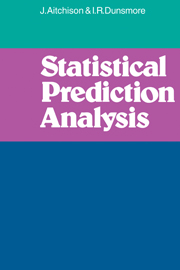Book contents
- Frontmatter
- Contents
- Preface
- 1 Introduction
- 2 Predictive distributions
- 3 Decisive prediction
- 4 Informative prediction
- 5 Mean coverage tolerance prediction
- 6 Guaranteed coverage tolerance prediction
- 7 Other approaches to prediction
- 8 Sampling inspection
- 9 Regulation and optimisation
- 10 Calibration
- 11 Diagnosis
- 12 Treatment allocation
- Appendix I
- Appendix II
- Bibliography
- Author index
- Subject index
- Example and problem index
3 - Decisive prediction
Published online by Cambridge University Press: 12 October 2009
- Frontmatter
- Contents
- Preface
- 1 Introduction
- 2 Predictive distributions
- 3 Decisive prediction
- 4 Informative prediction
- 5 Mean coverage tolerance prediction
- 6 Guaranteed coverage tolerance prediction
- 7 Other approaches to prediction
- 8 Sampling inspection
- 9 Regulation and optimisation
- 10 Calibration
- 11 Diagnosis
- 12 Treatment allocation
- Appendix I
- Appendix II
- Bibliography
- Author index
- Subject index
- Example and problem index
Summary
Point prediction
If we are asked to predict the outcome of a performance of a future experiment f our answer will clearly depend on how we view the consequences of being wrong. More specifically we may attempt to assess the relative consequences of being ‘close’ to the realised outcome and of being ‘badly’ wrong. If we can quantify these visualised consequences then we can present the problem as one of statistical decision theory. Since in constructing the predictive density function p(y|x) we have already carried out the information-extraction part of the problem we have a particularly simple confrontation in this decision problem. The components are as follows,
(i)Parameter set. The unknown outcome of the future experiment f plays the role of an unknown state of nature, so that Y, the sample space of f, is the parameter set of the statistical decision problem. Our assessment of the plausibility of a particular y at the time of making a decision is p(y|x), the predictive density at y.
(ii)Action set. The set A of possible actions is simply a reproduction of Y, since any element of Y is a possible prediction a.
(iii)Utility function. Associated with each prediction or action a and each realisable outcome y there is a utility or value U(a, y). We thus suppose defined a function U on the product domain A × Y.
Information
- Type
- Chapter
- Information
- Statistical Prediction Analysis , pp. 45 - 67Publisher: Cambridge University PressPrint publication year: 1975
